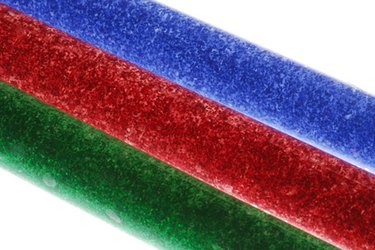Things You'll Need
Scrap fibers (felt, lint, thin cotton or linen), 1 cup per sheet of paper
Kitchen blender
School glue or cornstarch
Mixing bowl
Plastic mixing spoon
Metal window screen
Rectangular-shaped container (wider/longer than the window screen)
Water
Rolling pin
2 towels
Clothesline
Clothespins
Scissors

According to the Robert C. Williams Paper Museum, colonial paper was made from linen and cotton rags. The fibers were separated, pulped and mixed with sizing (an adhesive) to form sheets of paper. You can make your own colonial paper for school or craft purposes by re-purposing felt, lint, cotton or linen fibers and employing a little modern machinery into the mix.
Step 1
Shred felt, clothes dryer lint, thin cotton or thin linen fibers until you have a pile of threads/fibers. Rip the pieces by hand.
Video of the Day
Step 2
Pour water into a kitchen blender until the blender is three-fourths full. Add 1 cup of the shredded fibers to the water. Put the lid on the blender.
Step 3
Turn on the blender on a medium-high setting for about 30 seconds. Add more shredded fiber until the substance in the blender is lumpy like cooked oatmeal. The blender should remain three-fourths full.
Step 4
Pour the pulp into a large mixing bowl. Add 1 tbsp. of school glue or cornstarch to the pulp. According to Learn.com, cornstarch and glue act as a binder, also known as sizing. Mix the pulp with the sizing with a plastic spoon.
Step 5
Fill the large rectangular-shaped container with water.
Step 6
Pour the pulp onto the metal window screen. Immerse the screen into the water and shake it around gently to move the pulp over the screen. Use your hand to smooth the pulp over the screen. Don't immerse the screen/pulp too deeply or the pulp might float off the screen (1 to 4 inches is a good depth). Pull the screen up out of the container. Shake the screen over the container to drain the water.
Step 7
Lay a folded towel on top of the pulp on the screen. Put your hand on top of the towel and quickly, but gently, flip the screen over so the pulp falls onto the towel. Put another towel on top of the pulp.
Step 8
Use a rolling pin to roll the top towel back and forth to push the water from the layer of pulp between the towels. According to Learn.com, pressing on the pulp will also create a bond between the fibers within the pulp mixture.
Step 9
Remove the top towel and gently remove the paper. If it seems too soggy, put the towel back on and press with the rolling pin again. Lift the paper and hang it on a clothesline with clothespins, or leave it lying on the towel to air dry. One sheet of paper takes about 3 hours to dry on a dry, hot day.
Step 10
Cut the paper into rectangular sheets with scissors.
Video of the Day